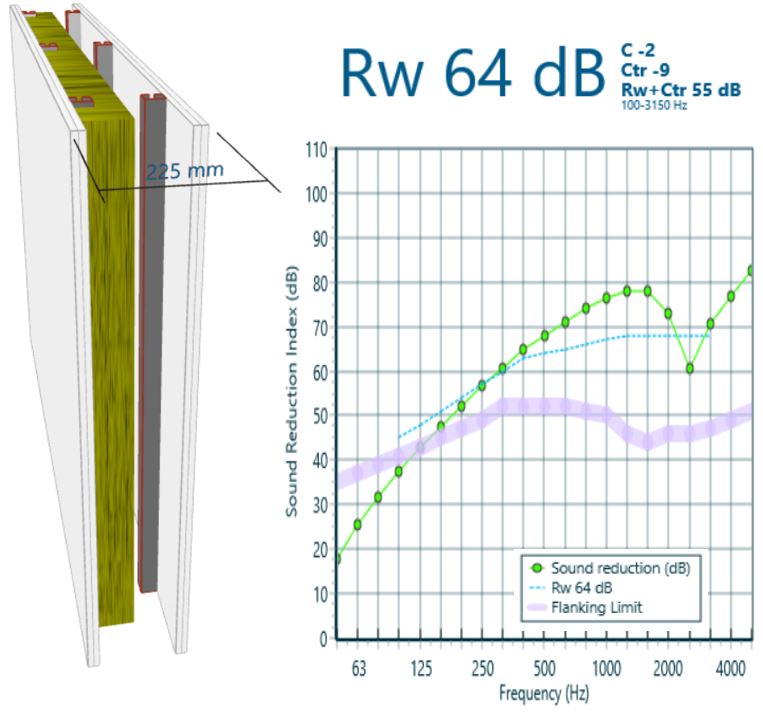Architectural Acoustic Design
Architectural acoustics (also called building acoustics) refers to the branch of acoustics concerned with sound within buildings. In most cases, this applies to the sound insulation between spaces within the same or adjoining buildings, typically party walls and floors.
Our team of acoustic consultants in London and Manchester are experts in providing design advice tailored to your project. We work across the UK to ensure optimal acoustic performance in buildings. Speak to our team today.
Our Architectural Acoustics Services
Clement Acoustics has extensive experience providing acoustic design advice for new builds and conversion projects. This experience provides us with the knowledge to ensure that your development complies with ADE’s requirements (Approved Document E of the Building Regulations).
Acoustic design advice would include recommendations for the following:
- Design of separating wall and floor systems
- Associated junction details
- Internal walls
- Service penetrations through partitions or floors
- Reverberation in sensitive rooms and common parts
- Elevators
- Doors
Based on the proposed room layouts, we would undertake a review to establish the required sound insulation performance of separating elements between dwellings. We would present a customised sound insulation upgrade solution, dependent on budgetary and performance requirements, referencing proprietary materials and suppliers as appropriate. Furthermore, we would undertake value engineering exercises to determine if any savings can be made while retaining the targeted sound transmission performance requirements. We often attend design team meetings to liaise with the team and provide recommendations.
| Design Criteria | ||
|---|---|---|
| Element | Airborne | Impact |
| Floor | DnT,W + Ctr ≥ 45 dB for new build DnT,W + Ctr ≥ 43 dB for change of use |
L'nTW ≤ 62 dB for new build L'nTW ≤ 64 dB for change of use |
| Wall | DnT,W + Ctr ≤ 45 dB for new build DnT,W + Ctr ≤ 43 dB for change of use |
- |
What is Building Acoustics?
Building acoustics is the field of engineering focused on managing sound within buildings. It primarily deals with sound insulation between spaces in the same building or adjacent structures. The main concerns include:
- Sound wave transmission through walls and floors
- Impact noise from footsteps and other vibrations
- Reverberation in rooms and common areas
- Acoustic performance of building elements like doors and elevators
Poor acoustic design can significantly impact a space’s usability. In residential settings, this means unwanted noise from neighbours, while in commercial spaces, it can affect privacy, productivity and comfort. Building regulations, such as Approved Document E, set specific requirements for sound insulation performance that must be met through proper acoustic design and verified through testing.
 Why is Architectural Acoustics Design Important?
Why is Architectural Acoustics Design Important?
Architectural acoustics is important as poor sound insulation can materially affect a space’s usability. Hearing unacceptable levels of noise from a neighbour (be it in a residential or commercial setting) can affect how a space can be used and enjoyed.
We have been involved in many projects where strict sound insulation requirements must be complied with for a building to be signed off. Examples of requirements are Approved Document E of the Building Regulations (ADE) or targeting acoustic BREEAM credits. Approved Document E requires UKAS Accredited Sound Insulation Testing for any new build or material change of use (i.e., conversion) residential development, a service we provide.
Whilst BREEAM may require the sound insulation to be 3 dB or 5 dB better than Approved Document E, This generally relates to flats and houses but can include other residential uses such as hotels or university halls of residence. Non-residential uses where building acoustics should also be considered include schools, offices, hospitals, and entertainment premises (such as cinemas).
To ensure your development complies with the requirements of Approved Document E, we would carefully design all separating walls and floors to achieve a good level of airborne and impact sound insulation performance.
Approved Document E design criteria for party elements
In addition to the above, ADE requires sound insulation between residential areas and non-domestic spaces (e.g., retail units, bars, restaurants) to be designed and built to suitably control unwanted noise transmission. Consequently, a higher level of sound insulation could be required in these cases than in the sound insulation between dwellings.
At What Stage Should I Seek Acoustic Design Advice?
It is recommended that an acoustic consultant be engaged as early as possible within the project timeline. Typically, the specification of sound insulation between dwellings (and between dwellings and non-domestic spaces) could be imposed as a Planning Condition, along with the specification of external façade elements. For larger projects, we can provide acoustic design advice for all RIBA stages.
Further, all residential developments must undergo Sound Insulation Testing for Building Control sign-off when the project is near completion.
Why Choose Clement Acoustics for Architectural Design Advice?
Quick turnaround time
Helpful team of qualified acoustic engineers
Competitive rates

